Archived Water Damage Blog Posts
Top Tips for Recovery From a Flood | SERVPRO of Temple & Belton
8/27/2024 (Permalink)
 Living room filled with flood water
Living room filled with flood water
No matter what season we are in here in the Temple area, flooding concerns are always a possibility. In fact, our community is considered part of “Flash Flood Alley,” which is a thin strip of land that runs right through central Texas.
We experience a higher number of flash floods or flooding issues than other parts of the country, so it is important to know what to do if a flash flood warning is issued for our area.
Flooding situations are overwhelming no matter what, which is why our flood restoration team explains more below about what to do when water starts rushing into your home.
Your Family’s Safety
Flash flood warnings can be issued at any time, even if the storm hasn’t come to town yet or if it is not actively raining in your neighborhood. You should start preparing as soon as the alert is issued so you aren’t scrambling as soon as the rain begins to fall. Head for home if you aren’t already there but avoid any roads that you know tend to flood quickly.
Quickly tie down anything that has the potential to be swept away, like your lawn furniture or grills, and get your car into the garage. If your home is known to flood, consider turning off the electricity to your lowest levels just to be on the safe side. Locate your emergency kit and find a safe spot on a higher level of your home to wait out the storm.
What to Do After the Rain Stops
Stay calm if water starts rushing into your house. There really isn’t much you can do in the moment, and you simply just have to wait until the conditions are safer to take action.
Once the water stops flowing in, move cautiously around your house since water can do a lot of structural damage in a short amount of time. Wear sturdy boots if you have to walk through any water as sharp objects or hazardous substances could be lurking in the water.
Once you have assessed the damage and assured yourself that your family and loved ones are safe, give us a call. Our team will start creating a personalized restoration plan right away. We will ask you to take as many images of the damage as possible, as this will help us with our plans and also help make your insurance claim process much smoother.
How We Dry Up Flood Water
Our first goal is to remove the excess water because we know that the longer water or residual moisture lingers, the worse the situation can get. Our air movers, blowers and other water extraction equipment will remove the water, and we will also get to work saving your fragile possessions and keepsakes. We pride ourselves on our restore rather than replace mentality, and we work hard to save whatever we are able to.
Once the water is gone and your home is secure once more, we can turn our attention to any necessary repairs. Water can instantly warp walls, floors and ceilings and it can also spark mold growth or mildew.
We will restore everything that was damaged, and we will sanitize your space to make sure a mold colony will not be able to grow. We will do whatever it takes to help you recover faster after you suffer a flood disaster.
Standing water in your home should always be cleaned up fast. Contact SERVPRO® of Temple & Belton right away.
Key Areas in Your Home Where Water Damage Is Common | SERVPRO® of Temple & Belton
12/4/2023 (Permalink)
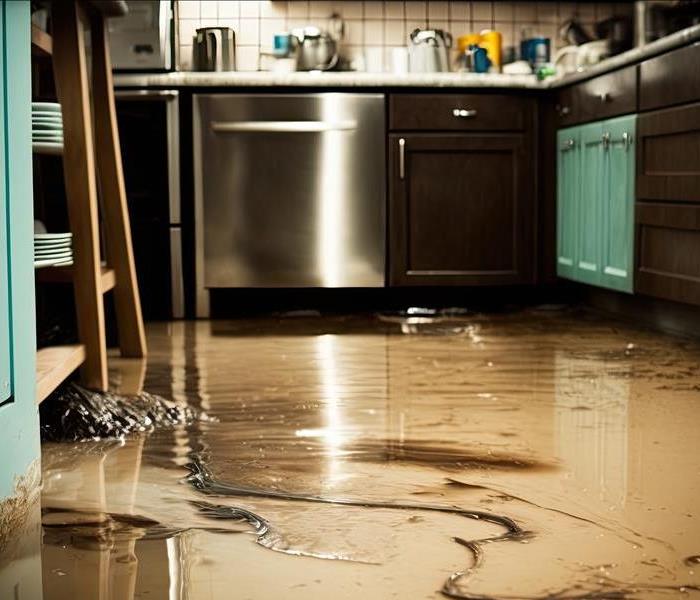 Flooded kitchen floor, water leaking. Closeup view of a waterlogged kitchen floor.
Flooded kitchen floor, water leaking. Closeup view of a waterlogged kitchen floor.
Chances are that you don’t give much thought to your water pipes or gutter system on a daily basis. You rely on them to keep water flowing through and around your home in a controlled way, and most of the time, they do!
However, one single malfunction or issue could cause all kinds of water issues for your home. Burst pipes, overloaded gutters and faulty appliances are all at risk of causing extensive water damage in a short amount of time.
By understanding where water damage is more likely to occur, you can take steps to address any emerging issues right away and minimize your situation. Our SERVPRO of Temple & Belton team explains more below, so read on to learn all about water damage in our homes.
Appliances and Pipes
The risk of a water leak is present wherever water is being used in your home. Dishwashers, water heaters and washing machines all have the potential to malfunction and leak. Keeping up on routine maintenance and checking around each appliance for water spots or signs of damage often can help you stop an emerging problem right away.
Your pipes are also vulnerable to wear and tear. Check the lines coming to and from your sinks, tubs and toilets and replace any old caulking or seals that you notice are starting to age. A single small crack in a fitting or the pipe itself can either cause a huge water disaster in a single event or it can occur gradually over a long period of time.
The Damages Caused By Mother Nature
We all know how destructive storms can be in the Temple area. Severe weather can bring heavy rain that can overload clogged gutters or it can leak down into your foundation and into your basement.
This is why cleaning your gutters regularly is crucial! Clean gutters encourage water to move down and away from your home, and that can’t happen if leaves or other yard debris are clogging up your system.
Floods are also a concern for this area. If your home is located in a flood zone, consider grading your property so that the land angles away from your home. This can help water naturally flow away from your house. You should also consider investing in a sump pump to help keep any water from getting into your basement.
How SERVPRO Can Dry Your Home
No matter how the water damage occurred, it can be frustrating or even overwhelming to decide where to start. The best first step is to call our restoration team! We are trained in every sort of water damage situation imaginable, and we have the tools, equipment and safety training to handle your recovery from start to finish.
We will remove any excess water or moisture, locate the source of the leak or issue, repair any problems we encounter and handle your damage recovery. That may seem like a large undertaking, but not to us! We are experts in disaster recovery, and we will help return your home to its preloss condition as quickly as possible.
Water damage should always be taken seriously. Call us right away at SERVPRO of Temple & Belton.
Everything You Need to Know About Dishwasher Leaks
7/14/2023 (Permalink)
A leaking dishwasher can quickly turn from a convenient appliance into a source of frustration and potential water damage in your home. In this blog, we will provide you with a comprehensive guide on dishwasher leaks. We'll explore the common causes behind dishwasher leaks, discuss preventive measures to avoid such incidents and guide you through the restoration process if you encounter a dishwasher leak in your home.
Causes of Dishwasher Leaks
Dishwasher leaks can occur due to various reasons. The most common causes include faulty door seals or gaskets, loose or damaged water supply hoses, clogged drain lines, and malfunctioning float switches or inlet valves. Additionally, overloading the dishwasher or using excessive detergent can lead to leaks by creating excess suds or causing excessive water pressure.
Preventing Dishwasher Leaks
Taking preventive measures can help you avoid the hassle and potential damage caused by dishwasher leaks. Regularly inspect the door seals and gaskets for any signs of wear or damage, and replace them promptly if needed. Ensure that the water supply and drain lines are securely connected and free from kinks or blockages. Avoid overloading the dishwasher and use the appropriate amount of detergent as per the manufacturer's recommendations. Performing regular maintenance, such as cleaning the filter and inspecting the spray arms, can also help prevent leaks.
Restoration Process for Dishwasher Leaks
If you experience a dishwasher leak, it's crucial to take immediate action to mitigate the damage. Start by shutting off the dishwasher's water supply and electricity. Carefully remove any standing water and dry the affected area to prevent further water damage or mold growth. Inspect the dishwasher components to identify the source of the leak and replace any damaged parts. Depending on the severity of the leak and resulting damage, you may need professional assistance for thorough cleanup, water extraction, and restoration of any affected surfaces or structures.
Understanding the causes of dishwasher leaks and implementing preventive measures can save you from the headache and expense of water damage in your home. Regular maintenance, prompt repair of faulty components, and proper usage practices are key to avoiding dishwasher leaks. However, if you do experience a dishwasher leak, acting quickly and seeking professional help for restoration can help minimize the damage and ensure your home is restored to its preloss condition.
Remember, if you encounter a dishwasher leak that is beyond your expertise to handle, it's best to contact a trusted disaster restoration professional, such as our SERVPRO of Temple & Belton team, who can provide specialized assistance and guidance throughout the restoration process.
Ways To Save Wet Documents, Books, And Photographs
3/18/2023 (Permalink)
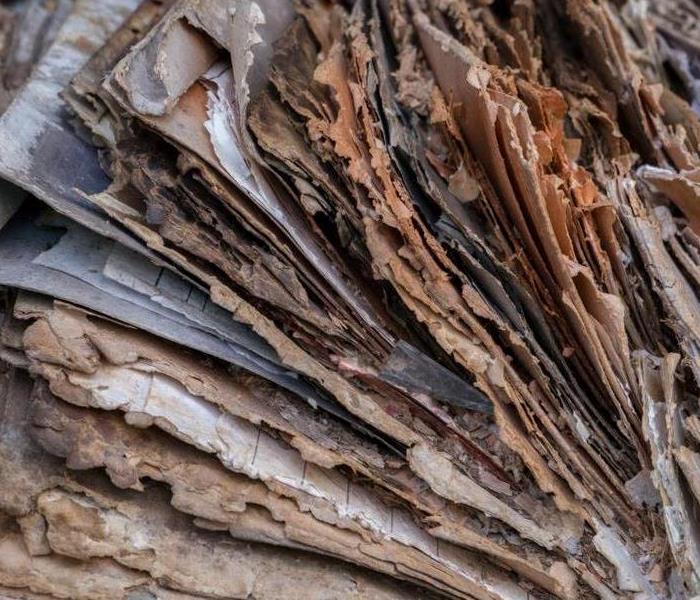 If your documents are damaged by water, give SERVPRO a call today.
If your documents are damaged by water, give SERVPRO a call today.
If you've ever had the unfortunate experience of a leak or flood in your home, you know that it can be devastating. Part of that experience can also include your documents, books, and photographs getting soaked. The best thing to do if this happens is to try and preserve the documents as best as possible. Here are some tips on how to salvage wet documents:
Wet Documents Need Attention Quickly
If you find yourself with wet documents, the first thing to do is to act quickly. If you don't and you wait too long, the document can be lost forever.
Your next step is to put your documents in a safe place where they can dry out completely. You also want to make sure that they are completely dry before putting them back into storage or filing cabinets so that mold growth doesn't occur again later on down the road!
Don't Use Heat
The most important thing to remember when you're trying to save wet documents is that heat can damage them. Heat can also help mold grow on your documents, which will make them unreadable and unusable. It's best if you can keep the documents cool instead.
Following a water damage event in your home or business, your attention will be needed in many different places at once. If you cannot focus your attention on saving wet documents at that moment, try freezing your documents! This will prevent any further damage, such as mold growth, from ruining your documents until you have the time to attend to them.
Air Dry
Place the documents on a dry surface. This can be a countertop, or even your kitchen table if you have enough room and it's not too messy. You want to make sure that they are far away from any sources of moisture or humidity, like windows or air conditioners.
Air drying is a good way to save wet documents because it doesn't require any special equipment or chemicals, but there are some drawbacks as well.
Air drying takes time--it may take days for all of the moisture in the document(s) to evaporate out through evaporation alone! If you have a lot of documents that need to air dry, it could also take up a ton of space. It is also time-consuming, as it requires consistent attention to ensure that the documents are drying properly.
Hire SERVPRO
The best thing you can do is to hire a professional restoration company like SERVPRO of Temple & Belton as soon as possible after the event occurs. They can begin drying out items as quickly as possible.
There are several reasons why it's important to hire professionals when dealing with wet documents. They have equipment designed specifically for drying out items like books and photographs (among others). This will ensure that they're dried properly without any damage being done in the process--and will save money down the line because these items won't need replacing due to mold growth or other issues caused by improper drying methods!
Digitize Documents
If you have wet documents, SERVPRO of Temple & Belton can help digitize your documents. We can scan the documents and save them to the cloud or print a copy for you. This way, even if your original is ruined by water damage, you will still have access to it!
Take Steps Immediately to Preserve Them
If you find out that your documents are wet, take steps immediately to preserve them. The longer you wait and the more water they absorb, the more damage is done to your papers. Most importantly, start drying them right away! This will prevent mold from forming, which will ruin your documents, books, and photographs.
Should I Worry About the Water in my Crawlspace?
11/14/2022 (Permalink)
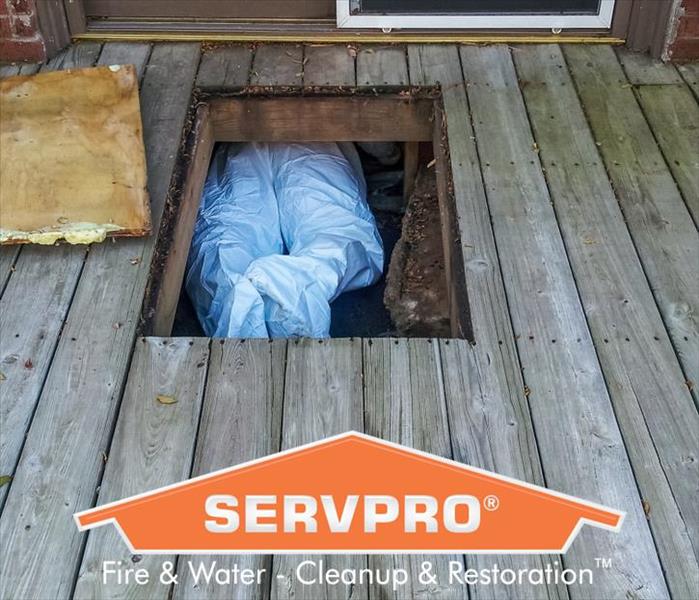 If your crawl space has water, don’t panic. It is normal for a crawl space to have some moisture in it.
If your crawl space has water, don’t panic. It is normal for a crawl space to have some moisture in it.
Should I Worry About The Water In My Crawlspace?
If you have water in your crawl space, don’t panic. It could be just a small amount of rainwater that came in from a window or a vent on the roof. It could also be indicative of bigger problems like leaking pipes or plumbing issues. Either way, it’s best to call an experienced professional to assess the situation and provide solutions for fixing it.
Why is there water in my crawl space?
There are several reasons why you might be having a problem with wet crawlspace:
The most common reason is that there is a leak somewhere in your home. If this is the case, you will need to call in an expert to find and fix the leak.
Crawlspaces can become damp because of condensation. This happens when warm air meets cool surfaces like stone walls or concrete floors. If this happens often enough and long enough, it can result in mold growth and rot issues that require professional intervention to correct them properly. While it may seem like no big deal now, something you should keep an eye out for if left alone too long could become quite serious later down the road… so do yourself a favor now by taking care of those problems before they get worse!
Don’t panic.
It's normal to be concerned when you notice a problem with the water in your crawlspace. However, there are plenty of things you can do to find out more about the issue and make sure it's not as serious as it might seem.
First things first: don't start doing anything yourself before calling in a professional. While it's tempting to try and fix the problem yourself, most issues like this require professional help in order to ensure that it’s treated correctly and safely! If possible, call in someone who knows what they're doing so they can help assess where exactly the issue lies before moving forward with any potential repairs or replacements needed.
Call a professional, like SERVPRO!
If you suspect that you have water in your crawl space, don’t panic. You can fix the problem and mold growth won't be an issue if it's handled correctly. Don't try to fix this problem yourself—you need a professional for proper diagnosis and treatment of any water-related issues in your crawl space. If you do attempt DIY repairs, there is a very high risk of injury or damage to your home's structure and contents, which could end up costing more than hiring a professional.
If your crawl space has water, don’t panic. It is normal for a crawl space to have some moisture in it. But if you notice more than just a little bit after heavy rainfall or snow melt, contact a professional immediately. They can inspect your property and determine the cause of the problem so that you can take proactive measures before any problems arise from it
An Explanation of Category 3 Water
7/26/2022 (Permalink)
 Category 3 water can find its way into residences in a few different ways
Category 3 water can find its way into residences in a few different ways
Unless it's confined to specific areas of your home such as showers, tubs, and sinks, you don't want to see water in your home. Something as seemingly simple as a leak can turn into a widespread flood, damaging building materials and ruining personal items. The situation is even worse if you discover black water. You need to know what you're up against if this issue shows up in your Academy, TX, house.
What Is This Type of Water?
When it comes to flooding, water comes in three different categories. Black water goes into the third category. It is the most serious because it poses the biggest threat to you and the people in your home. It is so named because it contains raw sewage, including human feces. It can also have other contaminants such as silt. This water can make you severely ill if you come in contact with it. If ingested, it can be fatal.
How Does it Infiltrate Homes?
Category 3 water can find its way into residences in a few different ways. A main sewer line backup or break could send the water in your home. An overflowing toilet can also flood your home with raw sewage. Another way that this category of water could invade your property would be from an overflowing waterway.
Calling the Pros
Residents can take care of small water cleanup tasks. However, black water is a job for the pros only. Professional sewage cleanup companies can provide the following:
- Protective equipment and gear to stay safe in the water
- Experience removing sewage from essential properties
- Proven tools and techniques to effectively clean up the area
A Thorough Process
Professionals technicians have the skills and training to remove all water and sewage from your home. The pros will also dry and sanitized all affected surfaces. The team can also handle any rebuilding or restoration.
Getting rid of black water isn't a chore you should face alone. Make sure you enlist the expertise of a professional.
How To Fix a Leaking Compression Faucet
7/19/2022 (Permalink)
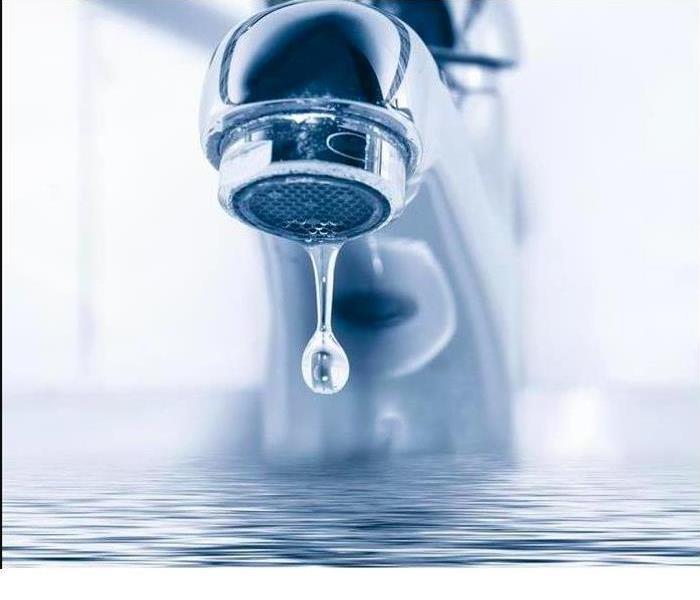 A minor repair of a leaking faucet is an easy DIY project
A minor repair of a leaking faucet is an easy DIY project
How To Fix a Leaking Compression Faucet
A leaking faucet is by far not the worst problem you can run into as a homeowner in Temple, TX, but it definitely needs to be addressed without hesitation. A dripping faucet can be annoying and expensive. A fast-dripping faucet can waste about five gallons of water per day, so a fixed leak can ease the strain on your wallet. If your faucet has a screw handle for hot water and another one for cold, you have a compression faucet. Take these steps to fix it.
1. Prepare the Work Area
Turn off the water to the sink. Close the sink drain to protect dropped parts. Create an area to lay out the parts in order of their removal. As you’re going through the process, it’s helpful to remove mineral deposits from the parts. Distilled white vinegar works well, along with a soft scouring pad.
2. Remove the Handles
Pry off the caps. Then, remove each handle by unscrewing them.
3. Remove the Nut
Remove the nut with a wrench. This will reveal the stem.
4. Remove the Stem
The O-ring rests on top of a rubber seat washer. The stem sits on the O-ring. The seat washer is the most likely cause of the leaking faucet; the rubber tends to wear out. Pull the stem out. You’ll find that the seat washer is thicker, whereas the O-ring is thinner. If the leak seems to be in the handle, the O-ring needs to be replaced. Be sure to take the used O-ring with you to the store to make sure you buy the correct size. Use a non-toxic, heat-proof plumber’s grease to coat the O-ring before installing it.
5. Remove and Replace the Seat Washer
An upside-down screw holds the washer in place. As with the O-ring, sizes vary, so take the used washer to the store for a reference. Then, apply plumber’s grease to the washer before you replace it.
6. Reassemble the Handles
The leak should be repaired. Now you can reassemble the handles.
A minor repair of a leaking faucet is an easy DIY project. If your home sustains damage, call water damage cleanup professionals to help.
The Top 3 Care Tips for Wet Items
4/18/2022 (Permalink)
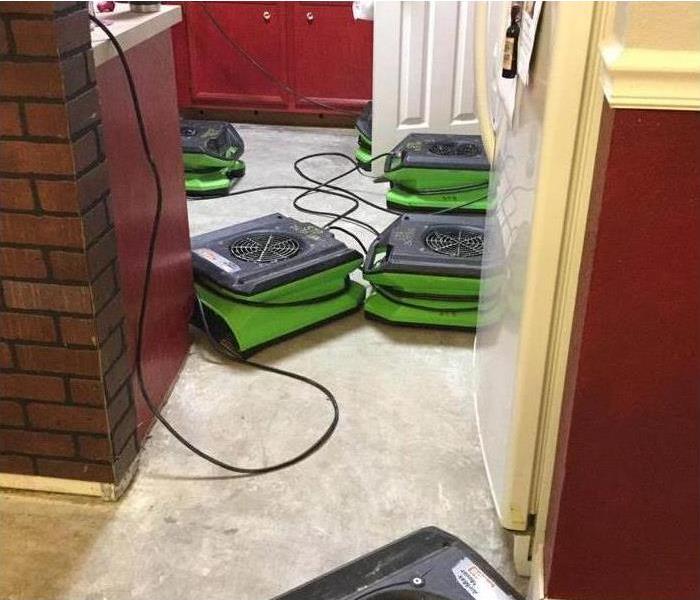 f a water damage event is not properly taken care of and dried, it can result in a mold infestation. Call SERVPRO for help.
f a water damage event is not properly taken care of and dried, it can result in a mold infestation. Call SERVPRO for help.
The 3 Most Important Wet-Items Care Tips
In the aftermath of water damage in Belton, TX, a homeowner may not be sure how to handle wet contents. The composition of each item determines the best approach to handling contents exposed to water in home. These three content care tips may be helpful for the earliest stages of water damage mitigation. Content restoration professionals can follow up with the best methods for restoring any materials.
1. Disinfect or Dispose of Contaminated Items
Disinfection is necessary for items contaminated with Category Two or Category Three water. Category Two Gray water may contain chemicals or microbes, and Category Three contaminated water contains solid waste. If damaged items are delicate, a homeowner should contact a content restoration service.
2. Consider Content Restoration for Delicate Items
Delicate items such as upholstery exposed to water in home may benefit from dry cleaning or other specialized processes. For instance, non-porous materials may benefit from immersion in cleaning solution and the application of ultrasonic waves. Wet books or papers can be freeze dried. These cleaning methods are done at a specialized off-site facility and items are stored until restoration of a residence is complete.
3. Try To Dry Out Items As Soon As Possible
Most items that stay wet or damp for days will sustain progressive damage and become more at risk for developing mold. For this reason, air drying is recommended for most contents, particularly items exposed to clean water from a broken pipe. Exercise caution exposing items such as furniture to heat or direct sunlight, which may bleach colors or cause wood to warp.
If you are not sure whether items can be recovered, consult with restoration specialists as soon as possible after water damage occurs at a residence in Belton, TX. Trained experts can recommend the best way to get out water in home or treat delicate contents at an offsite facility.
3 Reasons a Water Heater May Make Noise
2/7/2022 (Permalink)
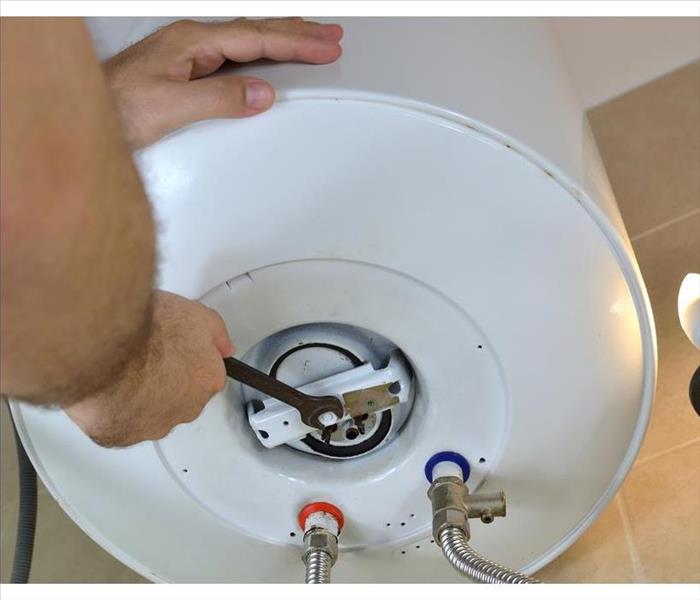 As water moves around the tank it can cause vibrations in the element which can lead to a possible humming sound.
As water moves around the tank it can cause vibrations in the element which can lead to a possible humming sound.
Three Reasons A Water Heater Might Make A Loud Noise
Most Temple, TX, homes have a water heater. One common occurrence that seems to happen with these units are a variety of unusual sounds. Fortunately, in most cases these sounds can be easily explained. Many professional restoration services agree that the following could cause sounds from a heater, and suggest looking for potential problems before you experience a break resulting in water damage.
1. Sediment Inside the Unit
In many cases, especially with heaters that have been in use for a while, settlement can get into the unit and settle. As this material is stirred, or in some cases as water is pushed through deposits, noises make can occur. A professional can perform a water heater flush to help correct this problem.
2. A Loose Heating Element
Another source of sound from your water heater could be the fact that the heating element isn't fully secured. As water moves around the tank it can cause vibrations in the element which can lead to a possible humming sound. Calling a professional to properly tighten the heating element may help to correct the problem.
3. Improperly Opened Valve
One noise common to water heaters is a high-pitched whistling type sound. In many cases this is caused when water is forced through a partially open valve, much the way steam tries to escape through the tiny opening in a teapot. In many cases you can look at your heater to ensure that all the valves are properly open in order to correct the sound.
When inspecting your water heater for the source of any unusual noises, try looking to see if there is an improperly open valve, a loose heating element, or any sediment inside the unit. The professional can perform a flush of your heating unit in order to clean out any of the elements, as well as replace or repair any damage parts.
3 Important Facts About Residential Water Damage
1/20/2022 (Permalink)
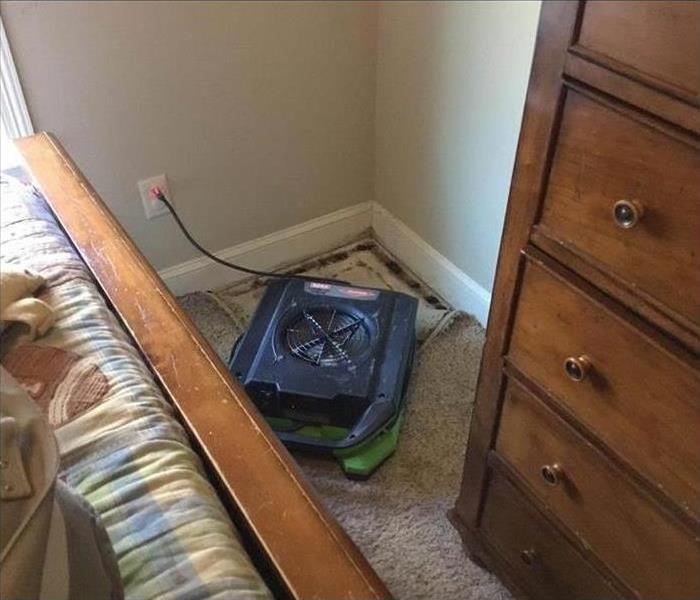 If a water damage event is not properly taken care of and dried, it can result in a mold infestation.
If a water damage event is not properly taken care of and dried, it can result in a mold infestation.
Protect Your Home During a Water Disaster
Whether a water pipe burst in cold weather or heavy rains caused a neighborhood flood, being prepared to protect your Marlin, TX, home during a water disaster can help you better understand what you can do to minimize damage and recover faster. Here are three quick facts to help you navigate a flooding emergency.
1. Small Floods Can Cause Significant Damage
Not all floods have to be large to cause damage. Some types of flooding, such as those that occur from a malfunctioning dishwasher or overflowing toilet, can affect your home’s walls and flooring. If a flood occurs in an area that includes carpeting or porous flooring, moisture may remain trapped underneath padding or tile, which can cause unpleasant smells and mold growth.
2. Not All Water Damage Is Instantly Visible
Sometimes water damage can occur out of sight, where it can affect the immediate surroundings for weeks or even months. For example, if a water line in your refrigerator’s automatic ice maker breaks and the water seeps into the wall behind the fridge instead of leaking onto the floor, you may not notice the problem until the moisture buildup starts to rot the drywall. It is a good idea to check plumbing lines regularly to prevent hidden leaks from causing more extensive damage.
3. Professional Restoration Can Prevent Future Problems
Whether a pipe burst and caused a flood or torrential rains were to blame, calling in a flood damage and restoration service to help with cleanup efforts can prevent future problems, such as trapped moisture under carpeting or damaged insulation behind drywall. Flood cuts and tear-out services may reveal these issues, and professional restoration can make damaged areas like new again.
Water damage can have a negative impact on your Marlin, TX, home. However, from outdoor flooding to a pipe burst caused by cold weather, knowing how to react to these events may help you reduce the risk of long-term moisture problems.



 24/7 Emergency Service
24/7 Emergency Service








